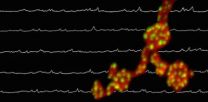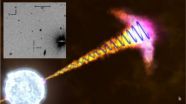(Press-News.org) During two days of intensive airborne measurements, oil and gas operations in Colorado's Front Range leaked nearly three times as much methane, a greenhouse gas, as predicted based on inventory estimates, and seven times as much benzene, a regulated air toxic. Emissions of other chemicals that contribute to summertime ozone pollution were about twice as high as estimates, according to the new paper, accepted for publication in the American Geophysical Union's Journal of Geophysical Research: Atmospheres.
"These discrepancies are substantial," said lead author Gabrielle Petron, an atmospheric scientist with NOAA's Cooperative Institute for Research in Environmental Sciences at the University of Colorado Boulder. "Emission estimates or 'inventories' are the primary tool that policy makers and regulators use to evaluate air quality and climate impacts of various sources, including oil and gas sources. If they're off, it's important to know."
The new paper provides independent confirmation of findings from research performed from 2008-2010, also by Petron and her colleagues, on the magnitude of air pollutant emissions from oil and gas activities in northeastern Colorado. In the earlier study, the team used a mobile laboratory—sophisticated chemical detection instruments packed into a car—and an instrumented NOAA tall tower near Erie, Colorado, to measure atmospheric concentrations of several chemicals downwind of various sources, including oil and gas equipment, landfills and animal feedlots.
Back then, the scientists determined that methane emissions from oil and gas activities in the region were likely about twice as high as estimates from state and federal agencies, and benzene emissions were several times higher. In 2008, northeastern Colorado's Weld County had about 14,000 operating oil and gas wells, all located in a geological formation called the Denver-Julesburg Basin.
In May 2012, when measurements for the new analysis were collected, there were about 24,000 active oil and gas wells in Weld County. The new work relied on a different technique, too, called mass-balance. In 2012, Petron and her colleagues contracted with a small aircraft to measure the concentrations of methane and other chemicals in the air downwind and upwind of the Denver-Julesburg Basin. On the ground, NOAA wind profilers near Platteville and Greeley tracked around-the-clock wind speed and wind direction.
On two days in May 2012, conditions were ideal for mass-balance work. Petron and her team calculated that 26 metric tons of methane were emitted hourly in a region centered on Weld County. To estimate the fraction from oil and gas activities, the authors subtracted inventory estimates of methane emissions from other sources, including animal feedlots, landfills and wastewater treatment plants. Petron and her team found that during those two days, oil and gas operations in the Denver-Julesburg Basin emitted about 19 metric tons of methane per hour, 75 percent of the total methane emissions. That's about three times as large as an hourly average estimate for oil and gas operations based on Environmental Protection Agency's (EPA's) Greenhouse Gas Reporting Program (itself based on industry-reported emissions).
Petron and her colleagues combined information from the mass-balance technique and detailed chemical analysis of air samples in the laboratory to come up with emissions estimates for volatile organic compounds, a class of chemicals that contributes to ozone pollution; and benzene, an air toxic.
Benzene emissions from oil and gas activities reported in the paper are significantly higher than state estimates: about 380 pounds (173 kilograms) per hour, compared with a state estimate of about 50 pounds (25 kilograms) per hour. Car and truck tailpipes are a known source of the toxic chemical; the new results suggest that oil and gas operations may also be a significant source.
Oil-and-gas-related emissions for a subset of volatile organic compounds (VOCs), which can contribute to ground-level ozone pollution, were about 25 metric tons per hour, compared to the state inventory, which amounts to 13.1 tons. Ozone at high levels can harm people's lungs and damage crops and other plants; the northern Front Range of Colorado has been out of compliance with federal health-based 8-hour ozone standards since 2007, according to the EPA. Another CIRES- and NOAA-led paper published last year showed that oil and natural gas activities were responsible for about half of the contributions of VOCs to ozone formation in northeastern Colorado.
This summer, dozens of atmospheric scientists from NASA, the National Center for Atmospheric Research, NOAA, CIRES and other will gather in the Front Range, to participate in an intensive study of the region's atmosphere, said NCAR scientist Gabriele Pfister. With research aircraft, balloon-borne measurements, mobile laboratories and other ground-based equipment, the scientists plan to further characterize the emissions of many possible sources, including motor vehicles, power plants, industrial activities, agriculture, wildfires and transported pollution.
"This summer's field experiment will provide us the information we need to understand all the key processes that contribute to air pollution in the Front Range," Pfister said.
INFORMATION:
CIRES is a partnership of NOAA and CU-Boulder.
Authors of "A new look at methane and non-methane hydrocarbon emissions from oil and natural gas operations in the Colorado Denver-Julesburg Basin," include 26 scientists from CIRES; NOAA's Earth System Research Laboratory; the Institute for Arctic and Alpine Research at CU-Boulder; the University of California, Davis; and the University of Colorado Boulder. Funding for the work, which is published in the Journal of Geophysical Research: Atmospheres, came from the Environmental Defense Fund, NOAA (the Office of Oceanic and Atmospheric Research and the Climate Program Office) and the National Science Foundation.
Airborne measurements confirm leaks from oil and gas operations
CIRES, NOAA study finds more methane, ozone precursors and benzene than estimated by regulators
2014-05-07
ELSE PRESS RELEASES FROM THIS DATE:
Astronomers create first realistic virtual universe
2014-05-07
Move over, Matrix - astronomers have done you one better. They have created the first realistic virtual universe using a computer simulation called "Illustris." Illustris can recreate 13 billion years of cosmic evolution in a cube 350 million light-years on a side with unprecedented resolution.
"Until now, no single simulation was able to reproduce the universe on both large and small scales simultaneously," says lead author Mark Vogelsberger (MIT/Harvard-Smithsonian Center for Astrophysics), who conducted the work in collaboration with researchers at several institutions, ...
Brain noise found to nurture synapses
2014-05-07
NEW YORK, NY (May 7, 2014) — A study has shown that a long-overlooked form of neuron-to-neuron communication called miniature neurotransmission plays an essential role in the development of synapses, the regions where nerve impulses are transmitted and received. The findings, made in fruit flies, raise the possibility that abnormalities in miniature neurotransmission may contribute to neurodevelopmental diseases. The findings, by researchers at Columbia University Medical Center (CUMC), were published today in the online edition of the journal Neuron.
The primary way ...
Native algae species to blame for 'rock snot' blooms in rivers worldwide
2014-05-07
VIDEO:
The recent appearance of the freshwater algae known as "rock snot " on river bottoms worldwide is caused by a native species responding to changing environmental conditions rather than by accidental...
Click here for more information.
The recent blooms of the freshwater algae known as "rock snot" on river bottoms worldwide are caused by a native species responding to changing environmental conditions rather than by accidental introductions by fishermen or the ...
Early depression, anger may taint love life even 20 years later, study shows
2014-05-07
A University of Alberta study is helping crack the code to happiness by exploring the long reach of depression and anger over more than two decades.
The study, published recently in the Journal of Family Psychology, followed 341 people for 25 years, and found that negative emotions they may have suffered as young adults can have a lasting grip on their couple relationships, well into middle age.
The fact that depression and anger experienced during the teen years clung to people, even through major life events such as child-rearing, marriages and careers was surprising, ...
Community doulas can be a big help for mother-baby relationships
2014-05-07
Young mothers are more likely to breastfeed and have positive relationships with their babies when they have another woman "mothering" them in the delivery room, according to new research at the University of Chicago on the value of doulas—women who help with deliveries and early care for mothers and babies.
The assistance from doulas is particularly valuable to young mothers from disadvantaged backgrounds. Those mothers sometimes receive help from women known as community doulas, who are from similar backgrounds as the young women and who visit them weekly for several ...
Emerald ash borers were in US long before first detection
2014-05-07
EAST LANSING, Mich. — New research at Michigan State University shows that the uber-destructive emerald ash borer arrived at least 10 years before it was first identified in North America.
The study, published in the current issue of journal Diversity and Distributions, shows that EABs were feasting on ash trees in southeast Michigan by the early 1990s, well before this pest was discovered in 2002, said Deb McCullough, MSU professor of forest entomology.
"We suspect they arrived inside wood crating or pallets imported from Asia where the beetle is native," she said. ...
Clues about black hole formation
2014-05-07
This news release is available in Spanish.
The work, which has had the participation of the Ikerbasque researcher Javier Gorosabal, co-director of the Associated Unit with the Institute of Astrophysics of Andalusia/CSIC-UPV/EHU, has been published in the prestigious journal Nature.
There is no other event in the cosmos that can compete in terms of energy and intensity with stellar explosions on the outer reaches of the universe and which are known as LGRBs (Long Gamma-Ray Bursts): in just one second a single GRB can emit as many as hundreds of stars like the Sun ...
How businesses can maximize revenue when introducing new products
2014-05-07
BUFFALO, N.Y. — Companies should use existing brand names and add new, sub-brand names to maximize revenue when introducing new products to market, according to a new study from the University at Buffalo School of Management.
Forthcoming in Management Science, the study notes a proliferation of new products in the consumer packaged-goods market each year. For example, U.S. manufacturers introduced more than 150,000 new products in 2010 alone. Of these, more than 90 percent were extensions of existing brand-name products.
"These new products can be line extensions, like ...
Regular doctor visits may greatly diminish skin cancer deaths
2014-05-07
VIDEO:
Melody Eide, M.D., M.P.H., a Henry Ford Hospital dermatologist and the study's lead author, says regular visits to the doctor may lead to significant reductions in melanoma mortality....
Click here for more information.
DETROIT – The risk of dying from the most dangerous type of skin cancer is significantly reduced with regular doctor visits, according to a Henry Ford Hospital study.
This is believed to be the first study of its kind to link melanoma mortality with ...
For slumbering diabetics, a way to detect low blood sugar and stop insulin delivery
2014-05-07
STANFORD, Calif. — New research could soon make it easier for people with type-1 diabetes to get a safe night's sleep, says a Stanford University School of Medicine scientist who led the study.
In a large trial conducted in patients' homes in the United States and Canada, scientists demonstrated that they could predict and prevent dangerously low overnight blood sugars in adolescents and adults with type-1 diabetes.
Very low blood-sugar levels can cause seizures or even, in rare cases, death. People with type-1 diabetes often sense warning signs of low blood sugar when ...
LAST 30 PRESS RELEASES:
Making lighter work of calculating fluid and heat flow
Normalizing blood sugar can halve heart attack risk
Lowering blood sugar cuts heart attack risk in people with prediabetes
Study links genetic variants to risk of blinding eye disease in premature infants
Non-opioid ‘pain sponge’ therapy halts cartilage degeneration and relieves chronic pain
AI can pick up cultural values by mimicking how kids learn
China’s ecological redlines offer fast track to 30 x 30 global conservation goal
Invisible indoor threats: emerging household contaminants and their growing risks to human health
Adding antibody treatment to chemo boosts outcomes for children with rare cancer
Germline pathogenic variants among women without a history of breast cancer
Tanning beds triple melanoma risk, potentially causing broad DNA damage
Unique bond identified as key to viral infection speed
Indoor tanning makes youthful skin much older on a genetic level
Mouse model sheds new light on the causes and potential solutions to human GI problems linked to muscular dystrophy
The Journal of Nuclear Medicine ahead-of-print tip sheet: December 12, 2025
Smarter tools for peering into the microscopic world
Applications open for funding to conduct research in the Kinsey Institute archives
Global measure underestimates the severity of food insecurity
Child survivors of critical illness are missing out on timely follow up care
Risk-based vs annual breast cancer screening / the WISDOM randomized clinical trial
University of Toronto launches Electric Vehicle Innovation Ontario to accelerate advanced EV technologies and build Canada’s innovation advantage
Early relapse predicts poor outcomes in aggressive blood cancer
American College of Lifestyle Medicine applauds two CMS models aligned with lifestyle medicine practice and reimbursement
Clinical trial finds cannabis use not a barrier to quitting nicotine vaping
Supplemental nutrition assistance program policies and food insecurity
Switching immune cells to “night mode” could limit damage after a heart attack, study suggests
URI-based Global RIghts Project report spotlights continued troubling trends in worldwide inhumane treatment
Neutrophils are less aggressive at night, explaining why nighttime heart attacks cause less damage than daytime events
Menopausal hormone therapy may not pose breast cancer risk for women with BRCA mutations
Mobile health tool may improve quality of life for adolescent and young adult breast cancer survivors
[Press-News.org] Airborne measurements confirm leaks from oil and gas operationsCIRES, NOAA study finds more methane, ozone precursors and benzene than estimated by regulators




